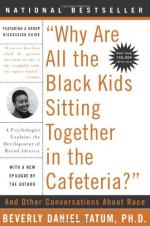
|
| Name: _________________________ | Period: ___________________ |
This test consists of 15 multiple choice questions and 5 short answer questions.
Multiple Choice Questions
1. What refers to a personally offensive act or word; deliberate act or display of disrespect?
(a) Virtue.
(b) Affront.
(c) Euthanize.
(d) Default.
2. What refers to the portion of American history that specifically discusses the African American or Black American ethnic group in the United States?
(a) African-American history.
(b) Cohesive physics.
(c) Postmodern psychology.
(d) Modern civilization.
3. What refers to a fact, occurrence, or circumstance observed or observable?
(a) Phenomenon.
(b) Antagonist.
(c) Catalyst.
(d) Emotion.
4. Why did Tatum's son assume a black boy was running down the street in an example given in Part II, Understanding Blackness in a White Context, Chapter 3?
(a) He was late for work.
(b) He had stabbed somebody.
(c) He had stolen something.
(d) The cops were chasing him.
5. Tatum explains that much of the pattern of stability and transition in midlife creates pressures on racial identities for Blacks where in Part II, Understanding Blackness in a White Context, Chapter 5, Racial Identity in Adulthood?
(a) In public.
(b) In school.
(c) In the home.
(d) In the workplace.
6. What refers to a particular tendency or inclination, especially one that prevents unprejudiced consideration of a question?
(a) Culture.
(b) Bias.
(c) Dominance.
(d) Subordinance.
7. What refers to a simplified and standardized conception or image invested with special meaning and held in common by members of a group?
(a) Alienation.
(b) Symbol.
(c) Stereotype.
(d) Curiosity.
8. What refers to that which is placed in or belonging to a lower order or rank?
(a) Peasant.
(b) Laborer.
(c) Subordinate.
(d) Superior.
9. What refers to a similarity between like features of two things, on which a comparison may be based?
(a) Redundancy.
(b) Allegory.
(c) Phyllogism.
(d) Analogy.
10. Title VIII of the Civil Rights Act of 1968 is commonly known as what?
(a) The Fair Housing Act.
(b) The Discrimination Nullification Act.
(c) Housing and Community Development Act.
(d) The Racial Equality Act.
11. Oppositional identities interfere with what, according to the author in Part II, Understanding Blackness in a White Context, Chapter 4, Identity Development in Adolescence?
(a) Sexual development.
(b) Achievement.
(c) Raising children.
(d) Workplace relationships.
12. What refers to the desire to learn or know about anything; inquisitiveness?
(a) Affirmation.
(b) Oppression.
(c) Curiosity.
(d) Inquisition.
13. Beverly Daniel Tatum earned her PhD in clinical psychology from which university?
(a) Boston College.
(b) Hartford Seminary.
(c) The University of Michigan.
(d) The CUNY Graduate Center.
14. What refers to an affective state of consciousness in which joy, sorrow, fear, hate, or the like, is experienced, as distinguished from cognitive and volitional states of consciousness?
(a) Hostility.
(b) Emotion.
(c) Immersion.
(d) Internalization.
15. What is the first stage of William E. Cross, Jr.'s theory of Nigrescence?
(a) Encounter.
(b) Immersion
(c) Internalization.
(d) Pre-encounter.
Short Answer Questions
1. When was Erik Erikson's book Childhood and Society published?
2. In what year did Erik Erikson emigrate with his family to the United States?
3. When did Erik Erikson die?
4. What is the third of Erik Erikson's life-stage virtues which is comprised of the ages from three to six?
5. What means to make an exclusive claim to?
|
This section contains 458 words (approx. 2 pages at 300 words per page) |

|




